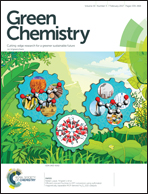Superhydrophobic functionalization of cutinase activated poly(lactic acid) surfaces†
Abstract
Superhydrophobic materials have focused the interest of many researchers due to their potential in a wide spectrum of applications like microfluidics or biosensors in the biomedical field. Typically, the increased surface roughness at the micro or nano scale needed for superhydrophobic surfaces is achieved by coating of different substances, which in combination with a lower surface energy lead to Water Contact Angle (WCA) values greater than 150°. Here, limited enzymatic surface hydrolyis poly(lactic acid) (PLA) was combined with spin coating of a steraic alkene ketene dimer (AKD) layer. The selective enzymatic hydrolysis creates, in a gentle and controlled way, new hydroxylic and carboxylic groups on the polymer surface without damaging the material bulk properties like alkaline treatment does. The creation of new hydrophilic surface groups lead to a significant increase in the hydrophilicity, decreasing the WCA to less than 30° while raising the roughness from an Rrms of 50.5 to 90.8 nm concomittantly increasing the exposed surface vs. the projected one by 13.2%. Coupling of PLA hydroxy groups with AKD was demonstrated by using a PLA model substrate and subsequent identification of the reaction product via LC-TOF/MS. On the PLA film, FTIR based detection of the characteristic β-ketoester bond peak between the AKD and enzymatically generated hydroxy groups on the surface confirmed successful coupling. Scanning Electron Microscopy (SEM) & Atomic Force Microscopy (AFM) imaging confirmed the presence of fractal structures after curation of the enzymatically activated PLA film. The suitable size, 4.15 μm on the lateral dimension and 0.7 μm on height of the structures, together with the high density of these fractal structures lead to a superhydrophobic surface (WCA >150°). This process represents an alternative to produce chemically inert superhydrophobic bio-based polyesters surfaces, by combining mild biocatalytic activation of a polyester film with non-toxic chemicals in an environmentally friendly manner.



 Please wait while we load your content...
Please wait while we load your content...